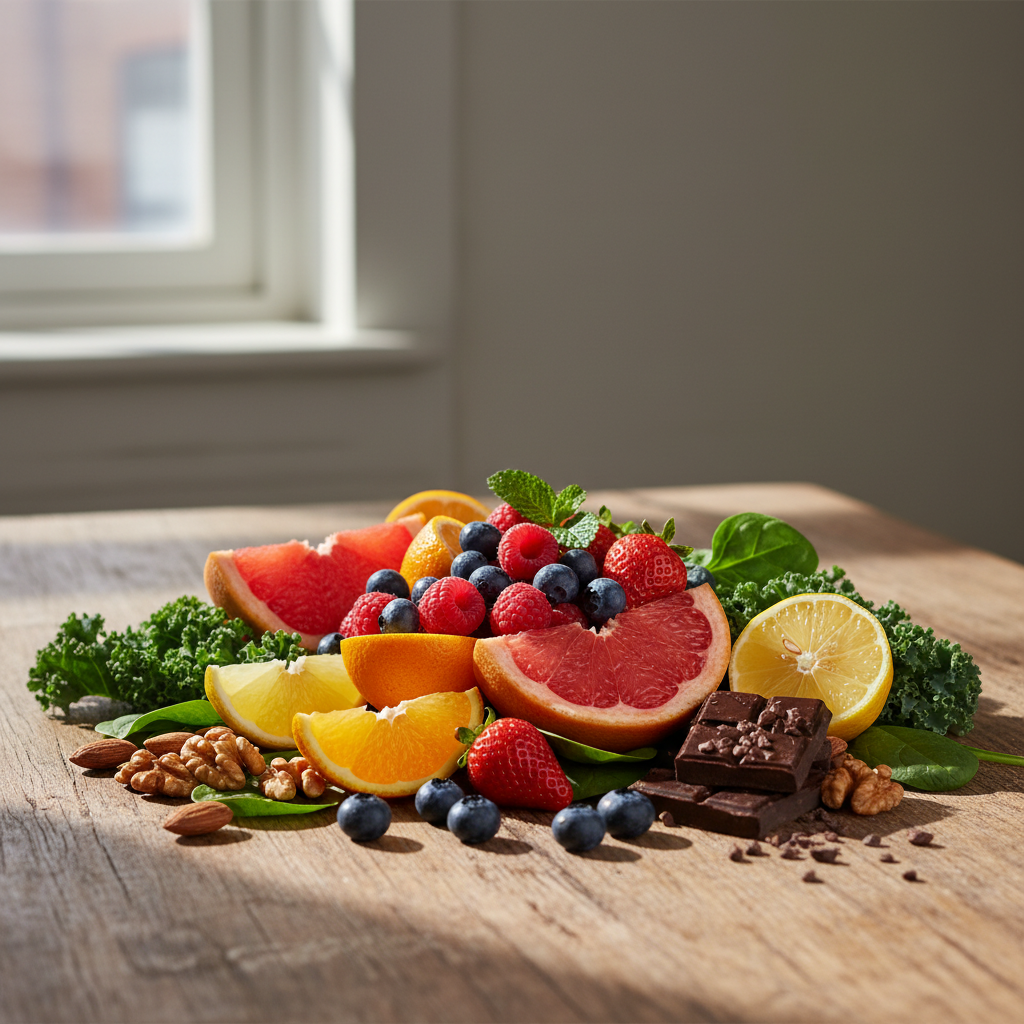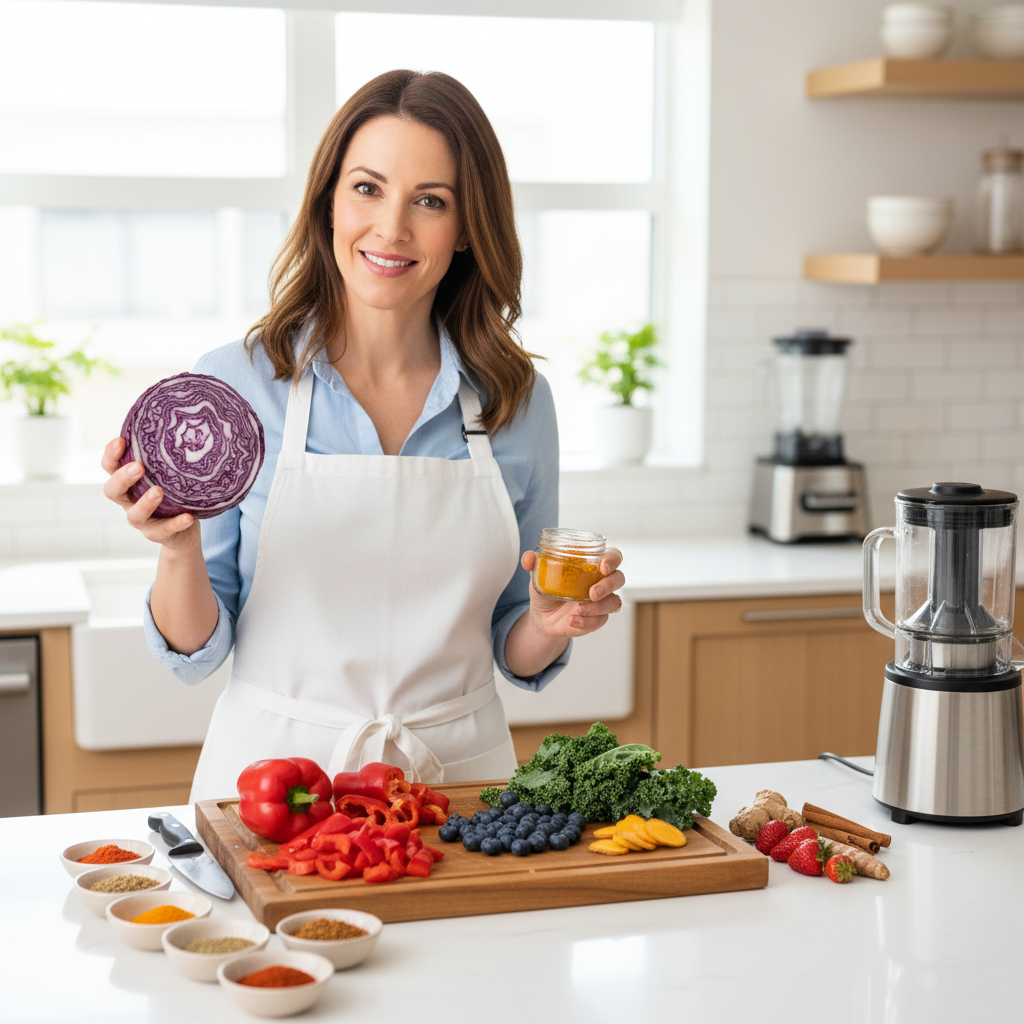
Table of Contents
Introduction
Have you ever wondered why some foods are celebrated as superfoods for their incredible health benefits? Antioxidant-rich foods have garnered significant attention in recent years as vital components for boosting overall health and protecting the body from damage. By including these powerful foods in your diet, you can enhance your body’s defenses, improve well-being, and potentially lower the risks of chronic diseases. This introduction will guide you through the importance of antioxidants, why they matter, and how eating the right foods can make a substantial difference in your health journey.
Antioxidants are naturally occurring compounds found in many foods that play a critical role in neutralizing harmful molecules called free radicals. These free radicals are unstable atoms that can cause oxidative stress, a condition linked to various health issues such as inflammation, aging, and the development of certain diseases. When your body encounters oxidative stress, it struggles to maintain balance and proper function. The protection antioxidants provide helps stabilize free radicals, reducing the risk of cell damage and supporting your body’s natural repair processes.
Eating foods rich in antioxidants is more than just a trendy health tip; it addresses foundational aspects of wellness that impact daily life. Whether you are an athlete striving for optimal performance, someone managing mental well-being, or simply interested in a healthier lifestyle, antioxidants offer tangible benefits. For example, a healthy nutrition plan that incorporates these foods can transform your life by promoting balanced nourishment and vitality. Incorporating antioxidant-rich foods naturally aligns with broader nutrition strategies designed to support long-term health and energy.
Beyond physical health, the connection between nutrition and mental health is gaining increased recognition. Certain antioxidant compounds support brain function and may help reduce symptoms of stress and cognitive decline over time. Learning about nutrition and mental health reveals practical insights into how your diet influences emotional well-being and cognitive performance. Understanding antioxidants within this context emphasizes why choosing the right foods matters not only for your body but also for your mind.
What You’ll Learn in This Guide
In this comprehensive guide, we’ll explore everything you need to know about foods rich in antioxidants and how they contribute to better health. Here’s what you can expect to learn:
- Understanding Antioxidants: We will break down what antioxidants are, how they function in the body, and why they play a critical role in combating oxidative stress and cellular damage.
- Top Foods Rich in Antioxidants: Discover the most nutrient-dense foods packed with antioxidants, including fruits, vegetables, nuts, seeds, and spices that can easily be added to your meals.
- Health Benefits: Learn about the proven advantages of consuming antioxidant-rich foods, from disease prevention to enhancing skin health and slowing the aging process.
- Practical Tips for Incorporation: We’ll provide actionable advice on how to include antioxidant-rich foods in your daily diet, with meal ideas, shopping tips, and storage recommendations to preserve their nutritional value.
This guide is designed to empower you with knowledge and practical strategies to make healthier food choices confidently. Whether you want to improve your diet for overall wellness or target specific health goals, knowing about antioxidants is a powerful first step.
As we progress, we will delve into detailed sections covering the science behind antioxidants, profile key foods known for their antioxidant properties, and explain the many ways these foods support optimal health. In addition, we will offer guidance on how to seamlessly integrate these foods into your everyday meals to maximize their benefits.
By the end of this article, you will have a strong understanding of why antioxidants are essential, which foods to prioritize, and how to tailor your diet for lasting health improvements. Prepare to embark on a journey of nutritious discovery that can transform the way you eat and feel. Let’s dive in and uncover the secrets of antioxidant-rich foods for a healthier, more vibrant life.

Antioxidants play a vital role in maintaining health by protecting our bodies against oxidative stress and damage caused by free radicals. These harmful molecules can accelerate aging and contribute to various chronic diseases, but antioxidants neutralize them, supporting overall wellness. This discussion will dive deeper into the wealth of foods rich in antioxidants and explore how incorporating them into your diet can promote long-term health. Whether you are curious about the best sources or practical ways to add these powerhouse nutrients to your meals, understanding antioxidants beyond the basics is the key to unlocking their full benefits.
Top Foods Rich in Antioxidants
Eating a diverse range of antioxidant-rich foods is foundational for combating oxidative stress and supporting immune function. There is an extensive variety of foods naturally abundant in antioxidants, spanning fruits, vegetables, nuts, spices, and even beverages. Prioritizing whole, unprocessed foods ensures you receive the best nutrient density and synergistic effects antioxidants offer. For example, berries such as blueberries and raspberries are famous for their high levels of flavonoids and vitamin C, critical antioxidants that help reduce inflammation and protect cellular health. Leafy greens like spinach and kale provide potent antioxidants like lutein and zeaxanthin which are essential for eye health.
Beyond fruits and vegetables, nuts and seeds such as walnuts and flaxseeds contribute valuable antioxidants alongside healthy fats, supporting brain and heart wellness. Spices including turmeric and cinnamon not only add flavor but have strong antioxidant properties that bolster the body’s defenses. Dark chocolate and green tea, popular antioxidant-rich foods, offer unique polyphenols that promote cardiovascular health and cellular repair. Including a colorful variety of these foods daily maximizes the spectrum of antioxidants, harnessing numerous health benefits.
Key Aspects of Antioxidant-Rich Foods
Considering the different categories, here are important points to understand about antioxidant-rich foods:
- Fruits High in Antioxidants: Berries such as blueberries, strawberries, and raspberries lead the pack with their high flavonoid and vitamin C content. Citrus fruits like oranges and lemons provide abundant vitamin C and flavonoids that improve immune response. Other fruits including apples, grapes, and cherries add to antioxidant variety by contributing compounds like quercetin and resveratrol.
- Vegetables with Strong Antioxidant Properties: Leafy greens (spinach, kale) offer carotenoids and flavonoids important for reducing eye damage and chronic inflammation. Cruciferous vegetables such as broccoli and Brussels sprouts are rich in sulfur-containing compounds like sulforaphane that trigger the body’s detox pathways. Colorful vegetables like carrots and bell peppers supply beta-carotene and vitamin C to reinforce antioxidant defenses.
- Other Antioxidant-Rich Foods: Nuts and seeds, including walnuts, almonds, and flaxseeds, contain vitamin E and polyphenols that protect heart and brain cells from oxidative damage. Spices and herbs—turmeric, cinnamon, oregano—contribute curcumin and other phenols with anti-inflammatory and antioxidant effects. Dark chocolate and green tea are cherished for their polyphenols, which support vascular health and may reduce disease risks.
- Synergistic Effect of Variety: Consuming a range of antioxidant foods ensures the intake of various compounds that act synergistically rather than in isolation. This natural combination boosts the overall neutralization of free radicals and supports comprehensive health benefits.
How to Incorporate Antioxidant Foods into Your Diet
Incorporating antioxidant-rich foods into daily meals not only improves health but can be a flavorful and enjoyable process. Practical strategies focus on variety, preparation methods, and accessibility to maximize nutrient retention and ease of inclusion. Simple tweaks to your grocery list coupled with smart meal planning allow antioxidant foods to become staples at every meal. This way, you continuously support your body’s defense system and reduce long-term disease risks naturally.
Starting with breakfast, adding berries to cereals or yogurt or including green tea as your morning beverage jumpstarts antioxidant intake early. Lunch and dinner options like colorful vegetable salads, steamed cruciferous vegetables, and meals that include nuts or seeds provide balanced antioxidants throughout the day. Healthy snacks with fruits, dark chocolate pieces, or spices incorporated into dishes add antioxidant support between meals. Additionally, shopping smart by choosing fresh and seasonal foods reduces oxidation and retains maximum nutrient content. Opting for organic produce may minimize pesticide exposure, which some believe can enhance antioxidant availability. Proper storage, such as refrigeration and avoiding prolonged exposure to light, further preserves these beneficial compounds.
Important Considerations for Incorporating Antioxidants
When adding antioxidant foods to your diet, keep these key points in mind:
- Meal Ideas to Boost Antioxidants: Start your day with antioxidant-rich berries in smoothies or oatmeal, enjoy colorful vegetable stir-fries or salads for lunch and dinner, and snack on nuts or a small piece of dark chocolate. These simple recipes integrate antioxidants effortlessly into daily routines.
- Shopping Tips: Prioritize fresh, seasonal produce to maximize antioxidant content. Seasonal foods are harvested at peak ripeness, offering higher nutrient levels. While organic options may reduce chemical residues, washing all produce thoroughly is essential regardless of type.
- Proper Storage to Preserve Nutrients: Store antioxidant-rich foods in cool, dark places or refrigeration to limit nutrient loss. Avoid prolonged exposure to air and heat during cooking to maintain antioxidant potency; methods like steaming or quick sautéing are preferable.
- Balance and Moderation: While antioxidants are beneficial, balance among food groups ensures overall nutrition. Avoid reliance on supplements alone, as whole foods provide complex matrices of nutrients working together for optimal absorption and effects.

Conclusion
In summary, antioxidants play a fundamental role in maintaining our health by protecting cells from oxidative stress and damage caused by free radicals. This article highlighted a variety of foods exceptionally rich in antioxidants, including vibrant berries, citrus fruits, leafy greens, cruciferous vegetables, nuts, seeds, and flavorful spices. Incorporating these nutrient-dense foods into your diet supports your body’s natural defense systems, potentially lowers the risk of chronic diseases, and slows the aging process. Understanding how antioxidants contribute to overall wellness encourages a more mindful approach to nutrition, linking the benefits of these powerful compounds with improved physical and mental health.
Antioxidants are more than just nutritional buzzwords; they are essential allies for your immune system and cellular repair mechanisms. The diverse array of antioxidant sources explained here—from sweet berries to robust dark chocolate and green tea—offers delicious and accessible options to enhance your daily meals. This variety helps ensure a wide range of antioxidant compounds and other beneficial nutrients work synergistically for optimal health effects. Being aware of both the benefits and the cautions associated with antioxidant supplementation stresses the importance of obtaining these compounds primarily through whole foods rather than isolated supplements.
Now that you understand the significance of antioxidants and the rich foods that provide them, taking actionable steps to include these foods in your diet is key. Start by consistently adding a colorful variety of antioxidant-rich fruits and vegetables to your meals and snacks. Consider breakfast options like berry smoothies or oatmeal topped with nuts, and incorporate leafy greens and cruciferous vegetables into lunch and dinner dishes. Snacking on nuts and seeds or enjoying a cup of green tea can also further boost your antioxidant intake throughout the day. Choosing fresh, seasonal, and if possible, organic produce can maximize the nutrient content and health benefits.
To expand your knowledge and deepen your nutrition journey, exploring broader concepts such as a healthy nutrition plan can provide useful frameworks to support sustainable eating habits that go beyond antioxidants alone. Additionally, understanding the connection between nutrition and mental health highlights how the right foods not only protect your body but also nourish your brain and emotional well-being.
In closing, embracing antioxidant-rich foods is a powerful and enjoyable way to invest in your long-term health and vitality. By making thoughtful food choices and balancing variety with moderation, you empower your body’s defenses, promote better aging, and support mental clarity. Keep exploring the wonderful world of nutrition to find what works best for your unique needs and lifestyle. Remember, your journey to better health begins on your plate, one antioxidant-packed bite at a time.
